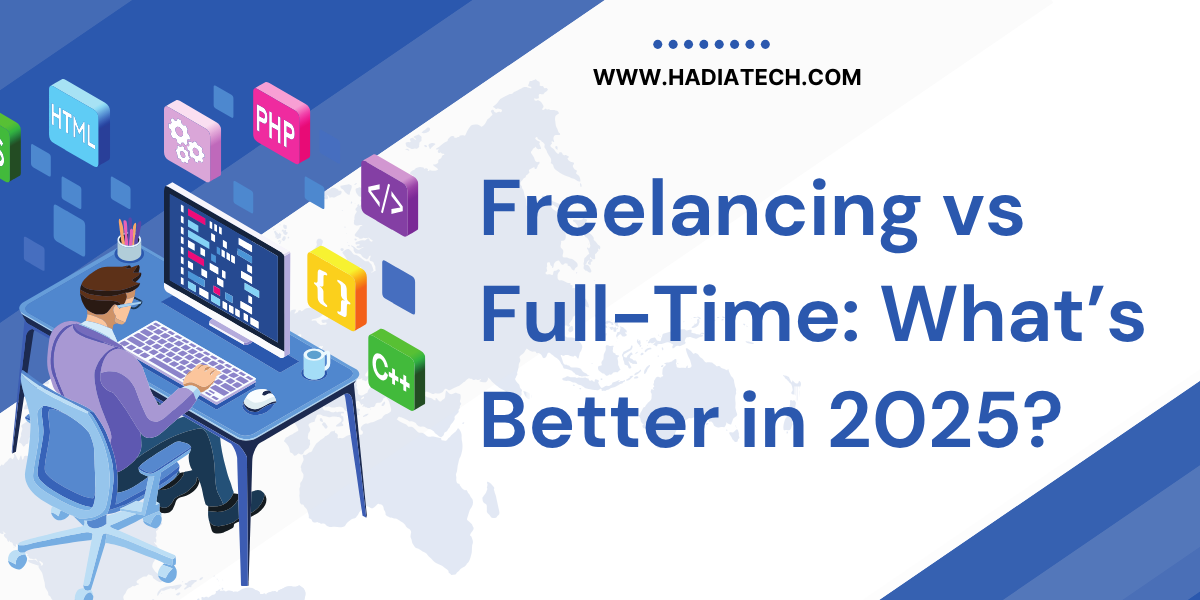Freelancing or Full-Time: What is Best in 2025?
Freelancing or full-time is a tough choice, having faced many challenges in 2025. Both have advantages and disadvantages, and it all depends on your goals, lifestyle, and career. The gig economy, online platforms, online remote work, and evolving workplace culture have made freelancing and full-time employment more popular than ever before. To help you decide which is best for you in 2025, this article examines the advantages and disadvantages of both. Let’s examine the most important factors to consider when considering full-time employment or freelancing. What Is Freelancing?
Freelancing is working alone for different companies, usually under contract. Freelancers can choose their hours, job, and employers. In 2025, by the efforts of companies such as Upwork, Fiverr, and LinkedIn, freelancing is easy to accomplish, linking experts with great opportunities everywhere in the world, although freelancing demands self-discipline, better marketing skills, and personal money management habits.

What Is Full-Time Employment?
Full-time work usually is with one employer, usually with a set schedule and benefits such as health insurance, holidays, and retirement. Full-time work in 2025 usually has remote or hybrid options and is less set than it used to be. Full-time work can have less of your work and schedule dictated by someone than freelancing.
Benefits of Freelancing in 2025
1. Flexibility and Autonomy
The most adaptable one is freelancing. You decide when you wish to work, can work from home, and pick your favorite projects and areas of specialization. Freelancing is ideal in 2025 when the co-working offices and digital nomad visas are at their best, when remote workers and work-life individuals are blessed with it.
2. Multiple Income Streams
Freelancers can work for several clients simultaneously, based on more than one source of income. The diversification ensures economic stability if a client of a project defaults. Programmers, graphic designers, and writers are needed in 2025, cashing in on potentially high-end incomes.
3. Skill Development
Freelancing implies that you work on different projects, and thus you are able to acquire different skills. From managing clients to taxes, freelancers wear many hats, and these are professionally good for them. Freelancers in 2025 can leverage AI tools to automate in a bid to focus more easily on high-value work.
4. Control Over Workload
The reason that you are a freelancer is that you can choose the amount and type of work that you do. You can therefore have the ability to control the amount of workload according to personal needs or financial objectives. Because of automation and platform software for gig economy platforms, as of 2025, freelancers are able to control their schedules effectively and participate in highly paid pieces.
Limitations of Freelancing as of 2025
1. Uncertain Income
I am unsure. Payment received may not be equal for all months. And it is a half-time job in itself, being capable of getting regular customers. Competition and piercing through the noise: In 2025, when all the employment releases are coming out from the gig platforms, differentiation has to be created to receive earnings regularly.
2. Perks
Compared to a regular employee, freelancing offers fewer the offering of advantages such as health cover, holiday pay, or pension saving. Freelancers pay such fees themselves, which in 2025 are expensive due to rising healthcare costs.
3. Self-Management Issues
Freelancing demands incredible organizational skills. From dealing with clients and billing them to handling taxes, freelancers manage everything businesslike. Since QuickBooks made it so simple in 2025, the process is still easy for more than a few individuals.

Benefits of Working as a Full-Time Employee in 2025
1. Economic Security
Full-time work gives a regular income, and the budget is easy. A majority of organizations will provide good pay and bonuses by 2025, yet in some fields, such as finance, health, and technology, particularly for financial security.
2. Benefits and Perks
Additional advantages accrue to full-time workers, e.g., medical benefits, paid leave, and pension plans. It is most probable that employers, by the year 2025, will offer wellness programs, mental health services, and remote working. It will make full-time employment more attractive by then.
3. Opportunities for career growth
Full-time employment will generate outright career development, such as promotions and job training. Businesses invest in employees in 2025, with access to training and qualifications that can generate long-term career opportunities.
4. Teamwork
Full-time employment offers a community and team environment. There can be mentorship, networking, and team-based working. Flexible working arrangements in 2025 include face-to-face and remote working, with a balance of flexibility and collaboration.
Disadvantages of Full-Time Work in 2025
1. Inflexibility
Schedules bound to full-time working restrict your freedom in planning your timings. The workplace flexibility of 2025 does not mean that employees cannot be compelled to come to work during certain specific hours, compromising autonomy.
2. Reduced Diversification
Monotony may be full-time employment, particularly for very technical jobs. Since one has to perform various types of jobs in freelancing, full-time workers can perform fewer types of jobs and become bored.
3. Risk of Layoffs
While permanent jobs are safe, permanent jobs always run the risk of being cut because of recession and other economic downturns. Permanent employees in 2025 can run this type of risk because of automation and the implementation of AI in working environments.

Freelancing or Full-Time: Issues to Tackle for 2025
In deciding between freelancing and full-time employment, take note of the following issues:
Lifestyle Preferences: If freedom and flexibility are your preferences, then freelancing will best fit you. If stability and routine are your issues, full-time work will best fit you.
Financial Objectives: Freelancers are remunerated handsomely but are prone to fluctuating incomes. Full-time work guarantees a guaranteed income but imposes boundaries on potential earnings.
Career Ambitions: Freelancing is ideal for people who like diversity and self-motivators. Full-time working is ideal for people who want long-term career growth in a company.
Risk Acceptance: Freelancing is more career risk-taking, and financially, full-time working is safer but less autonomous.
Which Is Better in 2025
No magic recipe. Freelancing in 2025 is for people who enjoy relying on their ability to be adaptable and love being masters of their vessels. Regular employment is suited for those who prefer to feel safe with stability, benefits, and a career path to navigate. Hybrid models combining freelancing with part-time work are gaining popularity, offering the best of both worlds.
Judge yourself by your capacity, financial requirement, and life, and then make the correct choice. If freelancing is new for you, work part-time along with staying full-time employed to try out the waters. The working climate in 2025 is more towards adaptability, so being flexible to take either of the offers will prepare you for prospects.
Conclusion
The future debate is actually about what will function best for your business and personal needs—freelancing or full-time in 2025.
Freelancing is diverse and adaptable work, but at the cost of unpredictable income as well as other management. Full-time employment, on the other hand, guarantees stability and employment benefits, but at the cost of adaptability. Keeping in mind the good work environment in 2025, balance the advantages over the disadvantages to your right needs and interests, either embracing the spirit of entrepreneurship or a full-time job that would be best for your career.





